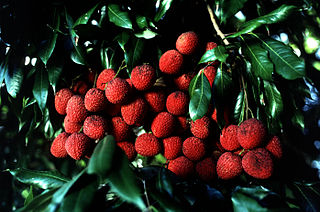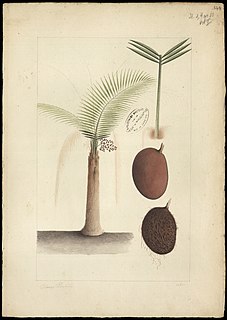
Melicoccus bijugatus is a fruit-bearing tree in the soapberry family Sapindaceae, native or naturalized across the New World tropics including South and Central America, and parts of the Caribbean. Its stone-bearing fruits are edible. It is also called Bajan ackee, genip, guinep, genipe, ginepa, kenèp, quenepa, quenepe, quenette, chenet, skinup, talpa jocote, mamón, limoncillo, canepa, skinip, kenepa, kinnip, huaya, or mamoncillo.

The Sapindaceae are a family of flowering plants in the order Sapindales known as the soapberry family. It contains 138 genera and 1858 accepted species. Examples include horse chestnut, maples, ackee and lychee.

Coccoloba is a genus of about 120–150 species of flowering plants in the family Polygonaceae, which is native to the Neotropics. There is no overall English name for the genus, although many of the individual species have widely used common names.

Psidium is a genus of trees and shrubs in the family Myrtaceae. It is native to warmer parts of the Western Hemisphere.

Paullinia is a genus of flowering shrubs, small trees and lianas in the soapberry family, Sapindaceae, native to tropical South America, Central America and the Caribbean.

Chrysophyllum is a group of trees in the Sapotaceae described as a genus by Linnaeus in 1753.

Hevea is a genus of flowering plants in the spurge family, Euphorbiaceae, with about ten members. It is also one of many names used commercially for the wood of the most economically important rubber tree, H. brasiliensis. The genus is native to tropical South America but is widely cultivated in other tropical countries and naturalized in several of them. It was first described in 1775.

Sapindus is a genus of about five to twelve species of shrubs and small trees in the lychee family, Sapindaceae, native to warm temperate to tropical regions of the world. The genus includes both deciduous and evergreen species. Members of the genus are commonly known as soapberries or soapnuts because the fruit pulp is used to make soap. The generic name is derived from the Latin words sapo, meaning "soap", and indicus, meaning "of India".

Talisia esculenta is a medium-sized tree native to the Amazon Basin, and is found in Brazil, Colombia, Peru, Paraguay and Bolivia.

Talisia is a genus of 52 species of flowering plants in the family Sapindaceae, native to tropical regions of the Americas. The genus is closely related to Melicoccus, with some species sometimes included in that genus.

Aiphanes minima is a spiny palm tree which is native to the insular Caribbean from Hispaniola to Grenada, and widely cultivated elsewhere. Usually 5–8 metres (16–26 ft) tall, it sometimes grows as an understorey tree and only 2 m (6.6 ft) in height.

Chelyocarpus is a genus of small to medium-sized fan palms which are native to northwestern South America. Some are upright trees, while others creep along the ground. Species are used for thatch, to weave hats, stuff pillows and as a source of salt.

Leopoldinia is a mostly monoecious genus of flowering plant in the palm family from northern South America, where they are known as jará palm or pissava palm. The two known species are commercially important, especially L. piassaba, which yields sustenance and construction material. The genus is named for Maria Leopoldina, archduchess of Austria, and Brazilian empress.

Mauritiella is a dioecious genus of flowering plant in the palm family found in South America where it is commonly called buriti. It is named after the similar and closely related genus Mauritia.

Ficus americana, commonly known as the West Indian laurel fig or Jamaican cherry fig, is a tree in the family Moraceae which is native to the Caribbean, Mexico in the north, through Central and South America south to southern Brazil. It is an introduced species in Florida, USA. The species is variable; the five recognised subspecies were previously placed in a large number of other species.
Hevea guianensis is a species of rubber tree in the genus Hevea, belonging to the family Euphorbiaceae. It is native to the rainforests of Ecuador, Venezuela, the Guyanas, Brazil, Colombia and Peru. It generally grows on well-drained soils or on those that are only lightly inundated, on river banks, in gallery forests, savannah forests and wooded slopes.
Paullinia paullinioides is a flowering plant species in the genus of Paullinia found in South America. It was first described in 1895, by Ludwig Adolph Timotheus Radlkofer.

Sapindoideae is a subfamily of flowering plants in the soapberry family, Sapindaceae. It includes a number of fruit trees, including Litchees, Longans, Rambutans, and Quenepas.
Arfeuillea is a monotypic genus in the family Sapindaceae with Arfeuillea arborescens as its only species. Commonly known as hop tree, this species is characterized by compound leaves arranged spirally around the branches, flowers with small white petals and larger red sepals, and dehiscent papery yellow fruits with two black seeds encased. It is native to Laos and Thailand but is cultivated only and not found in the wild. The species serves as a street tree across its native range and in Malaysia and Singapore, and its antioxidant-rich leaves are included in many Thai herbal medicines.















